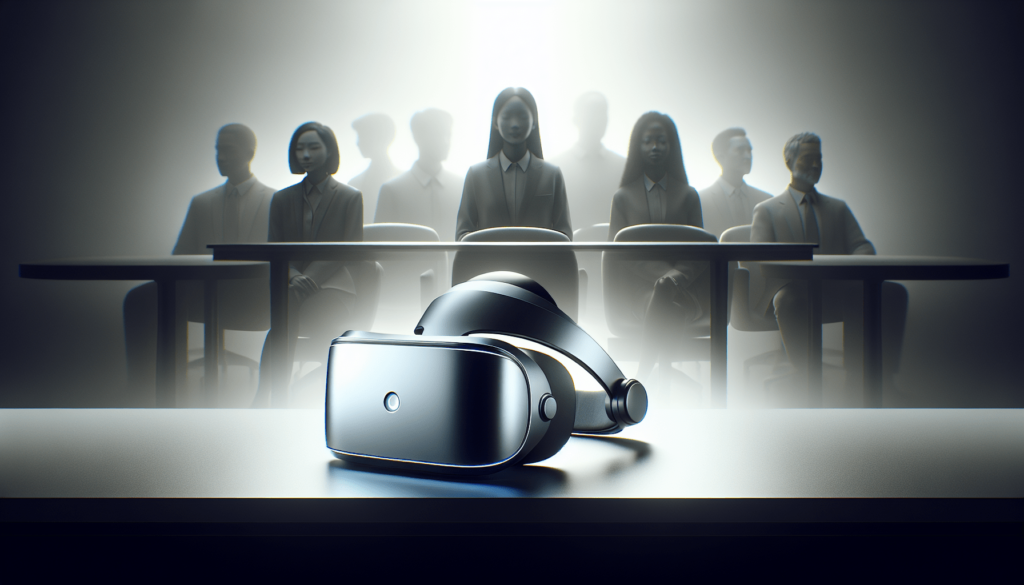Are you ready to transform your training approach for live chat support?
The world of technology is evolving faster than we can keep up with, often adding layers of sophistication and innovation that can enhance our capabilities.
Virtual Reality (VR), once merely the domain of gaming and entertainment, is now setting its sights on reshaping various industries, including customer service.
By 2025, the possibilities for using VR in live chat support training could be revolutionary, offering immersive experiences that traditional methods struggle to provide.
This article aims to serve as your comprehensive guide on leveraging VR for live chat support training in 2025.
You’ll discover how this technology can provide an engaging, realistic training environment that enhances agent skills and improves customer interactions.
Ready to take your live chat support skills to the next level? Discover how VR can transform your training experience in 2025!
Why Use VR for Live Chat Support Training?
What Makes VR an Effective Training Tool?
Imagine being able to step into a virtual environment where you can practice handling customer inquiries without the consequences of real-world mistakes.
This is the heart of VR’s effectiveness as a training tool. The immersive nature of VR allows you to feel as though you’re genuinely interacting with customers.
This sense of presence makes the learning experience more enjoyable and more impactful.
How Does VR Enhance Live Chat Support Training?
VR takes conventional training methods and elevates them by offering realistic simulations of customer interactions.
Picture yourself as an agent receiving customer queries in various scenarios; with real-time feedback, you can adjust your responses instantaneously.
This experiential learning ensures that you not only memorize solutions but internalize them through practice, making you more adept in actual service situations.
What Are the Advantages of VR Over Traditional Training Methods?
When comparing VR training to traditional classroom or online training methods, it’s evident that VR provides a dynamic experience that textbooks and video lectures cannot.
With VR, you create muscle memory and cognitive resonance that pencil-and-paper methods often fail to achieve.
Traditional training can be passive; VR fosters active participation in a simulated environment where you can practice scenarios repeatedly until you feel comfortable.
Is VR Training Accessible in 2025?
As we look forward to 2025, the question of accessibility arises. Fortunately, advancements in technology mean that VR training is becoming increasingly affordable and available.
Many companies are now producing budget-friendly VR headsets and software, allowing even smaller businesses to invest in these transformative training methods.
In fact, as VR technology becomes mainstream, the barriers to entry are coming down, making it a viable option for many companies.
How VR Works for Live Chat Support Training
What Are the Key Components of VR Training?
To effectively immerse yourself in VR training, you’ll need some essential components: VR headsets, controllers, and training software.
Popular options like the Oculus Quest or HTC Vive provide the hardware, while platforms like Microsoft Mesh lead the way in software capabilities.
These tools allow you to interact within the virtual space, creating a learning experience that aligns with real-world customer interactions.
How Do VR Simulations Mimic Real-Life Scenarios?
VR training harnesses the power of AI to craft realistic customer interactions.
By simulating various responses from customers — whether they are confused, angry, or satisfied — VR presents a layered approach to learning.
These simulations can include potential distractions, like phone calls or other customer chats, enriching the learning experience and preparing you for actual multitasking during support interactions.
What Role Does AI Play in VR Training?
The integration of AI in VR applications is a game changer. It allows for dynamic interactions where the customer’s responses can shift based on your performance.
For instance, if your response is empathetic, AI can escalate the simulation to a more positive outcome.
Alternatively, if you miss the mark, AI will adjust the scenario accordingly, providing you the opportunity to learn from your mistakes in real-time.
How Does VR Provide Real-Time Feedback?
The beauty of VR training lies in its capacity to analyze your performance as you train and offer actionable insights.
After completing a scenario, you might receive feedback on how quickly you resolved a query or how effectively you engaged with the customer.
This immediate feedback loop equips you with valuable information to enhance your future performance.

Top VR Tools and Platforms for Live Chat Support Training
What Are the Best VR Platforms for Training?
There’s no shortage of VR platforms available for customer support training. Notable options include:
| Platform | Features |
|---|---|
| Oculus for Business | Comprehensive suite for immersive training |
| HTC Vive | High-quality graphics and user interaction |
| Microsoft Mesh | Supports remote training and collaboration |
These platforms offer tailored experiences designed for various industries, making them versatile for training.
How to Use VR Chat Simulators for Practice?
Virtual reality chat simulators like VRChat and AltspaceVR are excellent for practicing live chat scenarios.
You can interact with other users in a controlled environment to build your communication skills.
These simulators can be customized for various training modules, allowing you to create practice sessions that reflect real-life interactions while learning from those who might be in the same training phase.
What Are the Best VR Training Programs for Customer Service?
Leading training programs like Strivr and Talespin are specifically tailored for customer support roles.
They draw on a wealth of industry knowledge to prepare agents through structured training scenarios.
By focusing on real-life applications and problem-solving, these programs help you hone your skills in a manner that mimics actual customer service conditions.
Are There Free or Affordable VR Training Options?
If you’re working with a limited budget, fear not! Several platforms offer free trials or affordable versions of their software.
Open-source tools can also be a great way to dive into VR training without overspending.
Budget-friendly VR headsets like the Oculus Quest 2 can also make high-quality VR more accessible, providing an entry point into this exciting training avenue.
How to Choose the Right VR Tool for Your Needs?
Selecting the right VR tool for your training can feel overwhelming, but focusing on a few key aspects can streamline the process.
Consider your budget, specific training goals, and the level of technical expertise available among your team.
Choose platforms that provide robust support and training capabilities in line with your company’s objectives.
Step-by-Step Guide to Using VR for Live Chat Support Training
Step 1: Set Up Your VR Training Environment
Creating an environment conducive to VR training is the first step.
Ensure you have the necessary hardware and software adequately set up in a quiet, distraction-free area.
Make sure your physical space is clear of obstacles to facilitate movement.
Step 2: Choose Realistic Training Scenarios
Next, it’s crucial to select training scenarios that reflect potential customer interactions accurately.
Consider using predetermined scripts or designing simulations based on frequently encountered issues.
Customizing these scenarios can enhance their relevance and make your training more effective.
Step 3: Practice Handling Common Customer Queries
Arming yourself with knowledge of typical customer queries is key.
Develop responses for common issues such as billing inquiries, technical support requests, and customer complaints.
Your VR training sessions should incorporate these scenarios to create a comprehensive preparation experience.
Step 4: Analyze Your Performance with VR Feedback
Post-simulation analysis should be part of every training session. Take notes on the feedback you received and focus on areas for improvement.
Tracing your progression over time will help you identify weak points and ensure steady skill enhancement.
Step 5: Repeat and Refine Your Training
Consistency is vital in mastering any skill. Make it a regular routine to engage with VR training. Consider evolving scenarios based on your performance.
As you refine your skills, introduce more complex challenges to keep pushing your abilities.

Benefits of VR Training for Live Chat Support Agents
How Does VR Improve Communication Skills?
Immersive training through VR allows you to work on verbal and written communication skills in a safe environment.
Engaging with simulated customers enables you to practice articulation and tone, key components in providing effective support.
How Does VR Help Agents Handle Stressful Situations?
With VR, you can simulate high-pressure scenarios where customers may be upset or demanding.
By preparing you for these situations ahead of time, VR empowers agents to handle stress more gracefully and effectively when real-world challenges arise.
How Does VR Enhance Multitasking Abilities?
In a busy support environment, multitasking is essential.
VR simulations often replicate simultaneous customer interactions, training you to balance various chats or tasks effectively, preparing you for the fast-paced nature of customer service.
How Does VR Build Confidence in New Agents?
Repeated practice in VR instills confidence in new agents.
They can walk through numerous scenarios, iterate their responses, and learn from their mistakes, ultimately feeling more assured about their skills when they handle real customer issues.
Overcoming Challenges in VR Training
What Are the Common Challenges of VR Training?
While VR training provides impressive benefits, it is not without its challenges.
Some people may experience motion sickness, while others may encounter high costs or technical difficulties.
Preparing for these issues will help set realistic expectations as you implement VR in training.
How to Make VR Training More Accessible?
Finding solutions to accessibility issues can foster a better learning environment.
Shared VR setups in the workplace or community gaming centers can expand opportunities for training.
Invest in affordable hardware options that make deploying VR training easier.
How to Stay Motivated During VR Training?
To keep your engagement levels high, incorporate gamification elements into training. Tracking progress and reward systems can motivate continued participation.
Engaging with peers for feedback and camaraderie also fosters a positive training atmosphere.
How to Integrate VR Training with Other Learning Methods?
Blending VR with traditional and online training avenues offers a holistic approach to learning.
Consider complementing VR sessions with online tutorials or classroom training to create a more rounded educational experience.
The Future of VR in Live Chat Support Training
How Will VR Technology Evolve by 2025?
Looking ahead to 2025, advancements like haptic feedback and enhanced AI integration are on the horizon.
These developments will deepen immersive experiences and make training even more impactful, providing richer interactions that mimic real customer encounters more closely.
What Role Will VR Play in Remote Work and Training?
As remote work continues to grow, VR will be pivotal in supporting virtual teams.
Companies can conduct immersive training sessions, ensuring that remote agents receive the same high-quality preparation as those in an office.
How Can Companies Prepare for VR-Driven Training?
Businesses should begin researching and investing in VR solutions that suit their needs.
Establishing a framework for training processes that incorporates VR can strategically position companies to take advantage of these innovative training opportunities.
What Are the Long-Term Benefits of VR for Customer Service?
Incorporating VR into training leads to potential long-term benefits such as improved customer satisfaction, enhanced agent performance, and even cost savings.
By investing in the right tools, companies can yield a significant return on their training investment.
Conclusion
The transformation that VR promises for live chat support training is clear.
By allowing users to engage in immersive, realistic simulations, this technology revamps how customer service training occurs, leading to improved skills and greater confidence among agents.
As you consider the possibilities, don’t hesitate to explore the various VR training options available and embrace this innovative approach.
Ready to revolutionize your training? Start using VR for live chat support today!
FAQs
What equipment do I need for VR training?
To engage in VR training, you’ll need a suitable VR headset, controllers, and compatible software. Popular choices include the Oculus Quest 2 and HTC Vive, alongside various training-specific platforms.
Are there free VR tools for live chat support training?
Yes, several platforms offer free trials or basic versions of their training software. Additionally, there are open-source VR tools available that can be used for practice at no cost.
How does VR compare to traditional training methods?
VR provides a more immersive and interactive experience compared to traditional training methods. It allows for realistic simulations and dynamic responses, significantly enhancing the learning process.
Can VR training help with multilingual customer support?
Absolutely! VR training can simulate interactions in various languages, allowing agents to practice multilingual support scenarios and build confidence in their language skills.
What industries are using VR for customer service training?
A variety of industries, from retail to technology, are implementing VR for customer service training. Companies are recognizing its effectiveness in enhancing agent skills and improving overall customer experiences.

